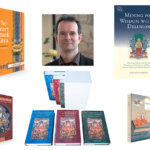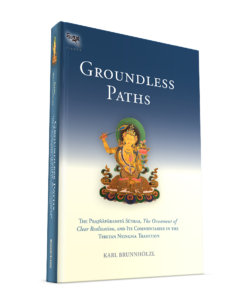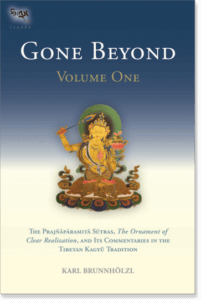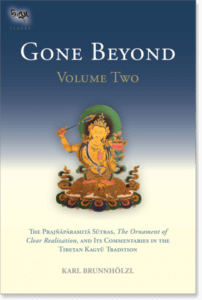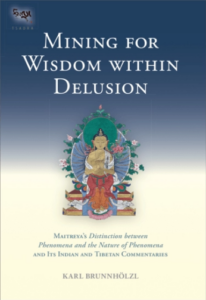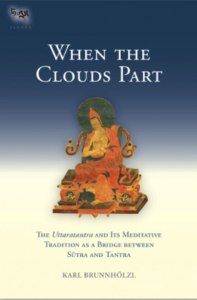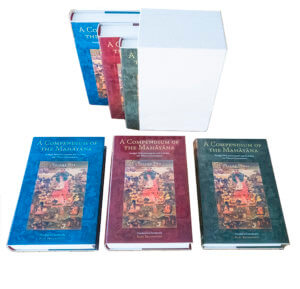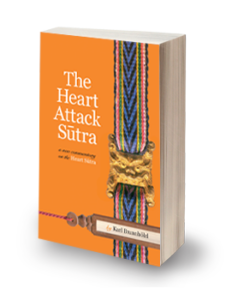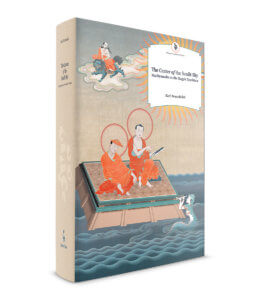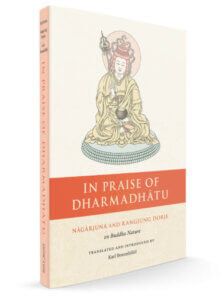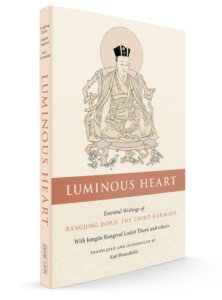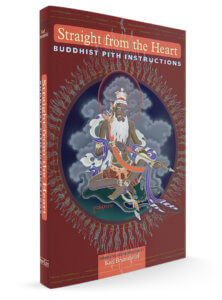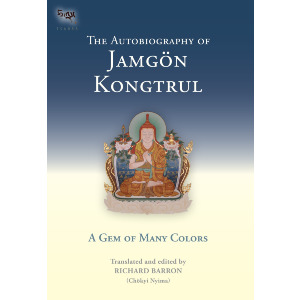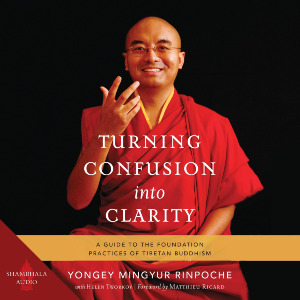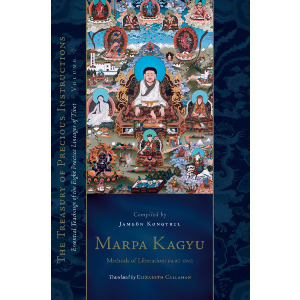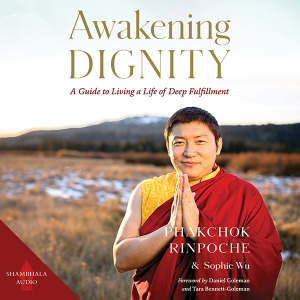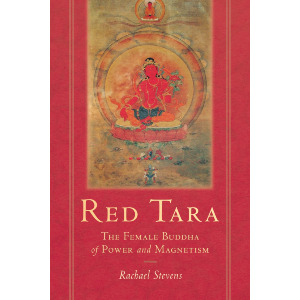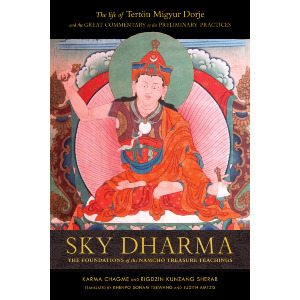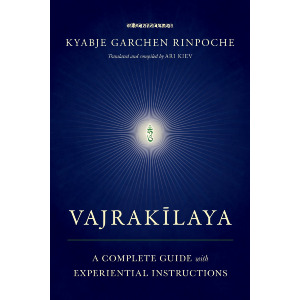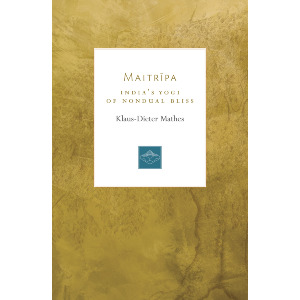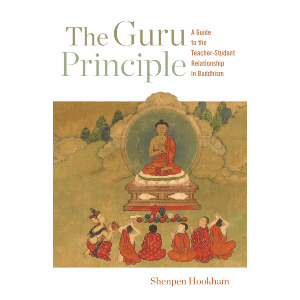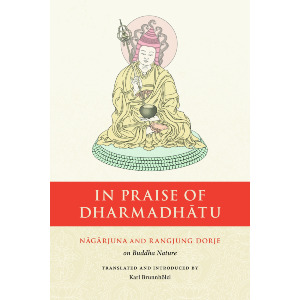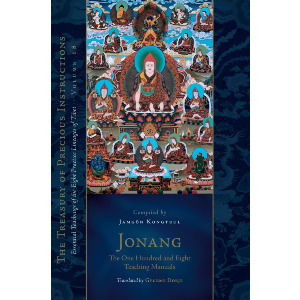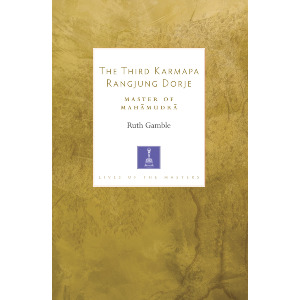
This guide for readers is dedicated to the works of author, translator, and teacher, Karl Brunnhölzl.
Originally trained as a physician, Karl Brunnhölzl later studied Tibetan language and Buddhist philosophy at the Marpa Institute for Translators and later the Nitartha Institute. Since 1989 he has been a translator and interpreter from Tibetan and English. He is presently involved with the Nitartha Institute as a teacher and translator.
Karl is well known among the Tibetan Buddhist community for his translations of some of the most widely known texts including works by Nagarjuna, Rangjung Dorje, as well as Five Maitreya Texts. Below you'll find an introduction to the selection of works found here at Shambhala Publications.
Texts and Commentary on the Prajñāpāramitā "Perfection of Wisdom" Sutras
The Prajñāpāramitā or "the Perfection of Wisdom" sutras are a collection of Mahāyana Buddhist scripture geared toward realizing the genuine nature of reality. The earliest texts that are included in the collection of Prajñāpāramitā sutras are believed to be from the 1st century BCE. Historically there have been a range of interpretations and schools of thought that derived from the Prajñāpāramitā sutras in India, most notably Madhyamaka and Yogācara, two distinct schools of thought stemming from Nāgārjuna and Asanga, respectively. Additional schools of thought have branched out from Madhyamaka and Yogācara, making their way to different regions of Asia including Japan, Tibet, China, and Korea.
In this reader guide we'll focus on the expansion of these two schools as they were explored in India and Tibet. As a Tibetan translator, interpreter, and practitioner in the Kagyu tradition, Karl Brunnhölzl offers of plethora of knowledge and experience enabling him to translate these complex and often dense philosophical texts from both the Madhyamaka and Yogācara tradition of Buddhism.
Perfection of Wisdom & the Five Maitreya Texts
According to the tradition, the Five Maitreya Texts were presented to Asanga by the bodhisattva Maitreya. These treatise include
1) The Ornament of Clear Realization (Abhisamayālaṃkāra)
2) The Ornament of the Mahayana Sutras (Māhayānasūtrālaṃkāra)
3) Distinguishing the Middle from the Extremes (Madhyāntavibhāga)
4) Distinguishing Phenomena from their Intrinsic Nature (Dharma-dharmatā-vibhāga)
5) The Sublime Continuum (Uttaratantra Śāstra)
Of the above treatise, Karl Brunnhölzl translated The Ornament of Clear Realization along with commentary from different schools of Tibetan Buddhism published as a trilogy (see below). Along the same vein, Brunnhölzl Compendium of Mahayana presents virtually everything anybody might want to know about the Yogācāra School of Mahāyāna Buddhism.
Abhisamayalamkara: The Ornament of Clear Realization
The Abhisamayalamkara summarizes all the topics in the vast body of the prajñaparamita sutras. Resembling a zip-file, it comes to life only through its Indian and Tibetan commentaries. Together, these texts not only discuss the "hidden meaning" of the prajñaparamita sutras—the paths and bhumis of sravakas, pratyekabuddhas, and bodhisattvas—but also serve as contemplative manuals for the explicit topic of these sutras—emptiness—and how it is to be understood on the progressive levels of realization of bodhisattvas. Thus these texts describe what happens in the mind of a bodhisattva who meditates on emptiness, making it a living experience from the beginner's stage up through buddhahood.
Groundless Paths
The Prajnaparamita Sutras, The Ornament of Clear Realization, and Its Commentaries in the Tibetan Nyingma Tradition
Translated by Karl Brunnhölzl
Groundless Paths contains the first in-depth study of the Abhisamayalamkara (the text studied most extensively in higher Tibetan Buddhist education) and its commentaries from the perspective of the Nyingma School of Tibetan Buddhism. This study consists mainly of translations of Maitreya's famous text and two commentaries on it by Patrul Rinpoche. These are supplemented by three short texts on the paths and bhumis by the same author, as well as extensive excerpts from commentaries by six other Nyingma masters, including Mipham Rinpoche. Thus this book helps close a long-standing gap in the modern scholarship on the prajñaparamita sutras and the literature on paths and bhumis in mahayana Buddhism.
Gone Beyond, Vol. 1 & Vol. 2
The Prajnaparamita Sutras, The Ornament of Clear Realization, and Its Commentaries in the Tibetan Kagyu Tradition
Translated by Karl Brunnhölzl
Gone Beyond contains the first in-depth study of the Abhisamayalamkara (the text studied most extensively in higher Tibetan Buddhist education) and its commentaries in the Kagyu School. This study (in two volumes) includes translations of Maitreya's famous text and its commentary by the Fifth Shamarpa Goncho Yenla (the first translation ever of a complete commentary on the Abhisamayalamkara into English), which are supplemented by extensive excerpts from the commentaries by the Third, Seventh, and Eighth Karmapas and others. Thus it closes a long-standing gap in the modern scholarship on the Prajnaparamita Sutras and the literature on paths and bhumis in mahayana Buddhism.
The first volume presents an English translation of the first three chapters of the Abhisamayalamkara and its commentary by the Fifth Shamarpa. The second volume presents an English translation of the final five chapters and its commentary by the Fifth Shamarpa.
In the video below listen to Karl Brunnhölzl discuss the trilogy on the Abhisamayalamkara: Groundless Paths and Gone Beyond Vol. 1 & 2.
Maitreya's Distinction between Phenomena and the Nature of Phenomena
Maitreya's Distinction between Phenomena and the Nature of Phenomena or Dharma-dharmatā-vibhaṅga is one of 13 core texts taught as part of monastic curriculum. The essential point of the text is, as the title entails, help a person distinguish between the illusory pheonemena of samsara and the ultimate reality, the nature of one's mind.
Mining for Wisdom within Delusion
Maitreya's Distinction between Phenomena and the Nature of Phenomena and Its Indian and Tibetan Commentaries
Translated by Karl Brunnhölzl
Maitreya’s Distinction between Phenomena and the Nature of Phenomena distinguishes the illusory phenomenal world of saṃsāra produced by the confused dualistic mind from the ultimate reality that is mind’s true nature. The transition from the one to the other is the process of “mining for wisdom within delusion.” Maitreya’s text calls this “the fundamental change,” which refers to the vanishing of delusive appearances through practicing the path, thus revealing the underlying changeless nature of these appearances. In this context, the main part of the text consists of the most detailed explanation of nonconceptual wisdom—the primary driving force of the path as well as its ultimate result—in Buddhist literature.
The Uttaratantra Śāstra "The Sublime Continuum"
The Uttaratantrashastra also called the Ratnagotravibhāga is another one of the 13 core texts studied in monastic shedras. In short, it is a commentary on the third turning of the wheel and focuses on the essential Buddhanature of all sentient beings.
When the Clouds Part
The Uttaratantra and Its Meditative Tradition as a Bridge between Sutra and Tantra
Translated by Karl Brunnhölzl
“Buddha nature” (tathāgatagarbha) is the innate potential in all living beings to become a fully awakened buddha. This book discusses a wide range of topics connected with the notion of buddha nature as presented in Indo-Tibetan Buddhism and includes an overview of the sūtra sources of the tathāgatagarbha teachings and the different ways of explaining the meaning of this term. It includes new translations of the Maitreya treatise Mahāyānottaratantra (Ratnagotravibhāga), the primary Indian text on the subject, its Indian commentaries, and two (hitherto untranslated) commentaries from the Tibetan Kagyü tradition. Most important, the translator’s introduction investigates in detail the meditative tradition of using the Mahāyānottaratantra as a basis for Mahāmudrā instructions and the Shentong approach. This is supplemented by translations of a number of short Tibetan meditation manuals from the Kadampa, Kagyü, and Jonang schools that use the Mahāyānottaratantra as a work to contemplate and realize one’s own buddha nature.
Additional Resources on the Five Maitreya Texts
The Mahāyānasaṃgraha "A Compendium of the Mahayana"
The Mahāyānasaṃgraha, published here with its Indian and Tibetan commentaries in three volumes, presents virtually everything anybody might want to know about the Yogācāra School of Mahāyāna Buddhism. It discusses in detail the nature and operation of the eight kinds of consciousness, the often-misunderstood notion of “mind only” (cittamātra), dependent origination, the cultivation of the path and its fruition in terms of the four wisdoms, and the three bodies (kāyas) of a buddha.
A Compendium of the Mahayana
Asanga's Mahayanasamgraha and Its Indian and Tibetan Commentaries
Translated by Karl Brunnhölzl
Volume 1 presents the translation of the Mahāyānasaṃgraha along with a commentary by Vasubandhu. The introduction gives an overview of the text and its Indian and Tibetan commentaries, and explains in detail two crucial elements of the Yogācāra view: the ālaya-consciousness and the afflicted mind (klistamanas).
Volume 2 presents translations of the commentary by Asvabhāva and an anonymous Indian commentary on the first chapter of the text. These translations are supplemented in the endnotes by excerpts from Tibetan commentaries and related passages in other Indian and Chinese Yogācāra works.
Volume 3 includes appendices with excerpts from other Indian and Chinese Yogācāra texts and supplementary materials on major Yogācāra topics in the Mahāyānasaṃgraha.
Perfection of Wisdom & Madhyamaka
Prajñāpāramitāhṛdaya "The Heart Sutra"
The Heart Sutra is a classic distillation of the Prajñāpāramitā Sutras, known for the famously stated "Form is emptiness, emptiness is form. Form is no other than emptiness, emptiness is no other than form"—a notable quotation in other Madhyamaka sutras and commentary. Often thought of as radical by some Buddhist thinkers, the Heart Sutra, along with the entire collection of Prajñāpāramitā Sutras pushes the barrier beyond conceptual thought through the doctrine of the two truths (relative and ultimate) pointing to the empty nature of outer and inner phenomena.
Brunnhölzl plays on this radical view of reality with the title of his commentary, The Heart Attack Sutra. To learn more about his choice of title check out the video below.
The Heart Attack Sutra
A New Commentary on the Heart Sutra
by Karl Brunnhölzl
The radical message of the Heart Sūtra, one of Buddhism's most famous texts, is a sweeping attack on everything we hold most dear: our troubles, the world as we know it, even the teachings of the Buddha himself. Several of the Buddha's followers are said to have suffered heart attacks and died when they first heard its assertion of the basic groundlessness of our existence—hence the title of this book. Overcoming fear, the Buddha teaches, is not to be accomplished by shutting down or building walls around oneself, but instead by opening up to understand the illusory nature of everything we fear—including ourselves. In this book of teachings, Karl Brunnhölzl guides practitioners through this 'crazy' sutra to the wisdom and compassion that lie at its core.
Madhyamaka in the Kagyu Tradition
While Brunnhölzl's above works present commentaries from a mix of Kagyu and Nyingma voices, the following works focus specifically on the Kagyu orientation to Madhyamaka.
The Center of the Sunlit Sky
Madhyamaka in the Kagyu Tradition
by Karl Brunnhölzl
Madhyamaka is a potent and universally accessible means of calming our suffering and awakening to our innate wisdom. The Center of the Sunlit Sky artfully rescues this brilliant teaching from its unwarranted reputation for intellectual opacity and reinstates it as a supremely practical tool kit for everyday living. The aim of this book is to take Madhyamaka out of the purely intellectual corner into which it unjustly gets boxed. It is an attempt to show how Madhayamaka actually addresses and works with all of our experiences in life.
The book follows the original Indian sources as well as the standard commentaries on Madhyamaka in the Kagyu School of Tibetan Buddhism. At the same time, these materials are adapted for a contemporary audience, combining the familiar sharpness of Madhyamaka reasonings (launching a massive assault on our cherished belief systems) with exploring the practical relevance of the Madhyamaka way of mind training.
Commentaries from the Third Karmapa, Rangjung Dorje
While the above books make a clearer distinction between the philosophcal traditions of Yogacara and Madhyamaka, Brunnhölzl also has two translations of works by the great Kagyu master Rangjung Dorje, the Third Karmapa. Indicative of the deeper levels of Kagyu philosophy and practice, the union of Yogacara and Madhyamaka represent some of the more subtle teachings of Mahayana Buddhism.
In Praise of Dharmadhatu
Nagarjuna and Rangjung Dorje on Buddha Nature
by Karl Brunnhölzl
Nāgārjuna's works sit at the heart of Mahāyāna Buddhist thought and practice, but he was renowned in Asia not only for his Madhyamaka work, but also his poetic collection of praises, most famously In Praise of Dharmadhatu. This book explores the scope, contents, and significance of Nāgārjuna’s scriptural legacy in India and Tibet, focusing primarily on this seminal work. The translation of Nāgārjuna’s hymn to buddha nature—here called dharmadhatu—shows how buddha nature is temporarily obscured in the experience of ordinary sentient beings, gradually uncovered through the path of bodhisattvas, and finally revealed in full bloom as buddhahood. Included is a translation of the text’s earliest and most extensive commentary by the Third Karmapa, Rangjung Dorje (1284–1339), supplemented by relevant excerpts from all other available commentaries.
Luminous Heart
Essential Writings of Rangjung Dorje, the Third Karmapa
by Karl Brunnhölzl
This extraordinary collection of writings on buddha nature by the Third Karmapa Rangjung Dorje (1284–1339) focuses on the transition from ordinary deluded consciousness to enlightened wisdom, the characteristics of buddhahood, and a buddha’s enlightened activity. The Third Karmapa’s unique and balanced view synthesizes Yogacara Madhyamaka and the classical teachings on buddha nature. Included are commentaries by Jamgön Kongtrul Lodrö Tayé that supplement the view of the Third Karmapa on two fundamental treatises on buddha nature, emphasizing the luminous empty mind of buddha nature as presented by the great Indian masters Maitreya and Asaṅga. For those practicing the sutrayāna and the vajrayāna in the Kagyü tradition, what these texts describe can be transformed into living experience.
Poetry, Song, and "Pith Instructions"
The last book for this reader's guide is a collection of teachings, songs of realization, and advice for practitioners on the path from both Indian and Tibetan masters.
Straight from the Heart
Buddhist Pith Instructions
by Karl Brunnhölzl
Straight from the Heart brings together an inspiring collection of Buddhist teachings, songs of realization, meditation instructions, and enlightened poetry—all chosen for their power to speak directly to the student. Drawn from Indian Mahayana and Vajrayana Buddhism as well as from all four schools of Tibetan Buddhism, some will impress with their beautiful poetry and powerful imagery, others with their profound power of instruction. Still others share personal advice for life that seems to come directly from the mouth of the author, and some serve as immediate and profound practice instructions. Several are just delightfully unconventional, even outrageous, letting in fresh air on petrified views or musty traditions. Most of them are simply unknown precious gems, which deserve a wider audience. Each of the works is preceded by a brief introduction and a short biography of its author. Many of these are legendary accounts of supernatural feats, edifying examples for students on the same spiritual path meant to expand their limited outlook with “mind-blowing” stories. Miraculous deeds, magnificent songs, and pithy instructions distinguish this collection assembled by the Buddhist scholar and translator Karl Brunnhölzl, whose years of work among dharma texts and his skill as a translator yield a rich mine of teachings all chosen for their ability to speak directly to the heart.

